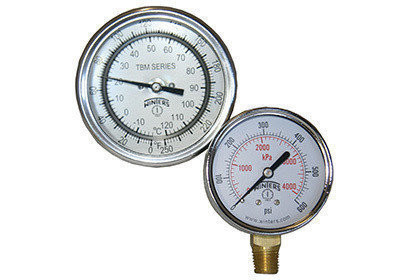Gauges
Proper instrumentation is important to know what operating conditions each component of your system are. The accuracy and function of these components let us know where a problem may lie or confirm to us that everything seems to be operating correctly. We offer brands from HO Trerice, Winters, Ashcroft and more.
If you do not see the part you want below, feel free to use the chat function and see if we possibly have the part you are looking for in stock.

Gauges Categories
What are Gauges & What is their function?
Gauges show how a boiler is operating
Every boiler needs to maintain a carefully controlled balance of pressures and temperatures to operate properly. Gauges help operators measure and monitor those parameters as well as the conditions inside the boiler to make sure it’s running safely and efficiently.
Gauges measure performance
From startup to shutdown and every moment in between, boiler operators need to know what’s happening in and around the boiler and the stack. Gauges provide a safe way to monitor water, fuel, air, steam, and exhaust temperatures and pressures to keep the boiler performing at its peak and operating within spec.
Different Types Of Gauges & How To Choose
WARE sells four different kinds of gauges:
Dry Pressure Gauges
Dry Pressure Gauges are standard round gauges with a moving needle. They are available in low- and high-pressure variations.
Liquid-Filled Pressure Gauges
Liquid-Filled Pressure Gauges have a dial that is filled with a clear fluid. They are ideal for harsher conditions where the gauge might experience vibration or impact because the fluid inside dampens sudden needle movements while protecting the gauge’s internal components from vibration and shock damage.
Water/Vacuum Gauges
Water/Vacuum Gauges are low-pressure gauges used to measure fuel pressure and air pressure, and can be used to measure water pressure in low-pressure boilers.
Thermometers provide temperature readings at several points in the fire side, the water side, and the stack to make sure the boiler is running safely, efficiently, and cleanly.
The Role Gauges Play In A Boiler
The conditions inside a boiler are extremely harsh, from the searing heat of the fire side to the scalding heat and pressure inside the tank. Gauges tell operators what’s happening inside, so they can make adjustments to the fuel, air, and water supplies for better operation.
What are The Effects Of A Bad gauge?
If a gauge is starting to fail, the readings it gives may not correspond to the performance of the boiler. If your readings seem off but the rest of the boiler seems normal, have the gauge inspected as soon as possible to make sure it’s performing properly.
Things To Consider About Gauges:
- Make sure your gauges are rated for their application. If a gauge isn’t designed for the conditions in which it’s used, it will fail.
- Make sure your gauges are safely rated for their pressure applications, as well. Using a high-pressure gauge in a low-pressure application will give less accurate readings, while using a low-pressure gauge in a high-pressure application could cause an explosion.
- Have gauges inspected and calibrated per the manufacturer’s recommendations to keep your boiler safe and efficient.
Helpful Resources
Relevant WARE Videos on Gauges
Protecting Steam Gauges and Switches with Siphon Loops
Reading Gas Pressure Gauges on Gas Train
Explaining Inch of Water Column
Steam Boiler Gauge Sight Glass Replacement
Explore over 750+ explanatory videos on boilers and boiler systems on our Youtube channel. Our videos can help you quickly grasp complex boiler topics. Watch more here!
Relevant WARE Blog Articles on Gauges
How to Clean a Boiler Glass Gauge
Knowing the Water Level in the Sight Glass
Our informative and educational blog content can help you gain a deeper understanding of the boiler room. Read more here!
Technical Documents
Gauges FAQ
How does a gauge work?
Gauges use a variety of ways to convey physical conditions into readable data. Some use pressure diaphragms to move their needles, while others use bimetallic strips or springs.
What’s inside a liquid-filled gauge?
Liquid-filled gauges are filled with an inert, splash-safe fluid, usually glycerin or silicon. It has to be clear, it has to be non-corrosive, and it has to be safe for humans should the gauge ever shatter.
Are there any other advantages to a liquid-filled gauge?
Yes, liquid-filled gauges tend to last longer. In addition to dampening needle movement, the liquid inside also acts as a lubricant for all the moving parts submerged in it. Since the gauge components have very little friction, they don’t wear down as quickly.




